


In 1843, a Danish author by the name of Hans Christian Andersen published an original fairy tale that quickly became a classic in Denmark and around the world. It was called The Ugly Duckling. Its story began with the hatching of a newborn duck, who unfortunately was viewed by the animals on the farm around him as an unhandsome little creature. He endured much abuse, and wandered from home to home looking for happiness. After a winter had passed and the ice had thawed, he was surprised to find acceptance in a flock of swans that had descended to the lake. Puzzled, he looked upon his reflection in the shimmering pools and found not a young, ugly duckling, but a grown and beautiful swan in its place.
It may be a stretch to go from recounting Anderson's renowned tale to discussing modern first-person shooters, but when beginning to review Crysis 3 the story made me consider the lack of maturation and growth the genre has experienced over the years. To me, the majority of them are still ugly ducklings - linear corridors crawls, spaced with the occasional cutscene, and pitting players against endless waves of mindless fodder. Despite the developers' attempts to win buyers with ever more explosive situations and fresh coats of paint, the core fundamentals tend to stay the same, leaving my anticipation cautious with each new announcement.
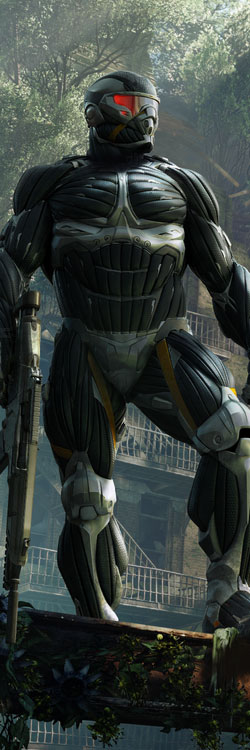 But I don't believe the genre is a lost cause. Rather, I find them the most promising when they open themselves up - perhaps taking elements from other genres in the process - and offering players the freedom of choice. That freedom can come in the form of open spaces or an influence on how the story will unfold, allowing the player to carve his or her own path through the game. It's no wonder then why games like Bioshock, Far Cry 3, Deus Ex: Human Revolution and, of course, the original Crysis are so appealing and enjoyable to me: the freedom to create my own chaos.
But I don't believe the genre is a lost cause. Rather, I find them the most promising when they open themselves up - perhaps taking elements from other genres in the process - and offering players the freedom of choice. That freedom can come in the form of open spaces or an influence on how the story will unfold, allowing the player to carve his or her own path through the game. It's no wonder then why games like Bioshock, Far Cry 3, Deus Ex: Human Revolution and, of course, the original Crysis are so appealing and enjoyable to me: the freedom to create my own chaos.
To my disappointment, Crysis' first sequel lacked some of that appeal. Gone were the expansive jungles of the fictional Lingshan Islands, replaced with the tighter roads and buildings of a New York City under siege. The nanosuit, a technological coat of armor that allowed for a various range of super human abilities, was streamlined. Not all of its changes were bad - it was still a fun game, more open than most - but it lacked some of the magic of its predecessor. With Crysis 3's announcement, I worried it would follow a similar formula, EA marketing be damned. Thankfully, Crysis 3 improves upon what came before, though not without losing some ground, as well.
Crysis 3 opens 24 years after the events of the previous game, with the alien Ceph forces all but eliminated. The mustache-twirling CELL corporation has assumed a place of dominance left in the power vaccuum, controlling the world's energy supply and using the people's reliance on it to force indentured servitude and obedience. Prophet, the ultimate hero of the series who has blended with the nanosuit to become more machine than human, is a prisoner of CELL and on his way toward experimentation. Before that can happen, however, rebel forces led by an old friend, Psycho, free Prophet and enlist his help to stop the company from controlling the world. But Prophet's visions point to a greater threat, the return of the Ceph, and it wasn't long into the game's six hour campaign until I was facing that familiar enemy.
The story works, in so far as to push me forward, but it's entirely predictable. Every twist is telegraphed, and it's ultimately a by the numbers affair. There are bad guys and aliens to stop and a world to save from total annihilation. The largest fault I have with it, however, is that there's no strong villain to contend with. The first Crysis had General Ri-Chan Kyong. Crysis 2 had Jacob Hargreave. Crysis 3 simply has uncommunicable enemy forces.
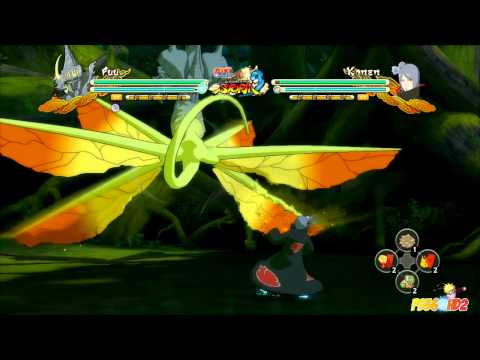 And while it does has themes about sacrifice and what it means to be human, the game doesn't explore them in any large amount of depth. Instead, it uses those questions to give us drama between Psycho, the man who longs for his suit, and Prophet, the man who is the suit. This is where the story works best. They're far more believable characters than they have been in the past, thanks in no small part to their wonderful animations and voice actors, and I heavily enjoyed every scene they had together. Crytek made me want to know how their stories would end. That's not something I can say about their or any other character in previous entries of the series.
And while it does has themes about sacrifice and what it means to be human, the game doesn't explore them in any large amount of depth. Instead, it uses those questions to give us drama between Psycho, the man who longs for his suit, and Prophet, the man who is the suit. This is where the story works best. They're far more believable characters than they have been in the past, thanks in no small part to their wonderful animations and voice actors, and I heavily enjoyed every scene they had together. Crytek made me want to know how their stories would end. That's not something I can say about their or any other character in previous entries of the series.
Similarly, the gameplay is two steps forward, one step back. The action takes place in the overgrown ruins of New York City, an environment filled with lush grass and rivers flowing through what were once busy avenues. Each area is sufficiently large, offering a wide number of tactical options and play styles. Multiple pathways gave me plenty of routes to sneak up on or evade my foes. Turrets and even specific Ceph units can be hacked to cause chaos amongst the ranks. The weapons all respond well, and I felt a sadistic pleasure at hearing the CELL forces panic as their numbers fell. It's a game that feels great with maps that give a greater sense of freedom than Crysis 2, but that freedom, aided by a specific new weapon and encounter designs, can come at a cost.
In a game like this, players can get exactly what they put into when it comes to difficulty levels. I prefer to play the role of a silent hunter, sticking to shadows and never being seen. That trivialized certain encounters in Far Cry 3, for example, but that's the cost of freedom in a sandbox shooter. The first two Crysis games attempted to balance that play style by having the cloak ability of the nanosuit drain energy quickly, and cost players their invisibility when firing while cloaked. But with Crysis 3's new Predator Bow, players can kill enemies without revealing their positions.
On one hand, that made me feel enjoyably powerful. The bow also has several ammo types which are all fun to use. Early in the game I dispatched a group of six soldiers with an air-burst grenade fired from my bow, leaving me with a grin. Helicopters were no match for my thermite-tipped arrows. Electricity arrows gave both human and Ceph forces satisfying shocks. However, aside from certain boss fights, it trivialized the difficulty.
In addition, the game spawns the player into the map with enemies spread out and unaware of their position. It doesn't force combat too often, at least not until nearing the end of the game, and because many objectives are to get from point A to B, it's entirely possibly to simply avoid engagements entirely. At several points I had to stop myself, asking if I really wanted to leave those poor enemies alive. Of course, when actively fighting the CELL and Ceph forces in the open, combat became more challenging, aided by the fact I could only wield two weapons at a time - excluding the bow - and could not carry and armory of ammo.
The story also had a say in how those encounters played out. Because there is no dominating villain, because the cast is so small - Prophet, Psycho and only two others - and because the brunt of the conflict is post modern civilization, the action is quieter than in Crysis 2. There were no exhilarating APC rides, fights alongside fellow soldiers nor epic confrontations at night against towering Ceph units. I may have felt like I had more options during the fights in Crysis 3, but as a whole they were markedly less exciting. Two steps forward, one step back.
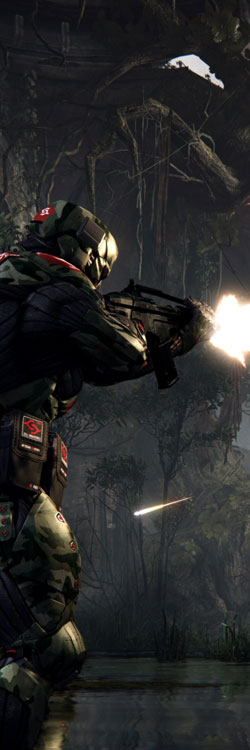 The nanosuit is an important piece to both those halves, as well. And as expected, its function is streamlined. Improved armor and the cloak are the only player activated abilities, while others are either automatic or obtained through upgrades. Only four upgrades can be active at a time, though presets can be stored, and there's quite a decent number of possible configurations. Crytek did a good job hiding the kits, despite the power of the suit's visor. It's worth knowing exactly what upgrades to unlock prior to investing the points. Overall, the suit is still a fun piece of hardware to command, but several games in and numerous abilities hacked and hidden away, it's lost some of its shine.
The nanosuit is an important piece to both those halves, as well. And as expected, its function is streamlined. Improved armor and the cloak are the only player activated abilities, while others are either automatic or obtained through upgrades. Only four upgrades can be active at a time, though presets can be stored, and there's quite a decent number of possible configurations. Crytek did a good job hiding the kits, despite the power of the suit's visor. It's worth knowing exactly what upgrades to unlock prior to investing the points. Overall, the suit is still a fun piece of hardware to command, but several games in and numerous abilities hacked and hidden away, it's lost some of its shine.
If it's not the story nor the gameplay that has won over crowds, then it's certainly the franchise's graphics. Cyrtek is known for being an industry leader when it comes to making the most visually impressive games to date, and Crysis 3 once again proves that reputation true. The texture work, animations, lighting and environments are all spectacular. I spent far too many moments simply staring at lush fields of grasses and the reflections of light on water that illuminated the objects around it.
Better still, the engine scales incredibly well. From low to very high, the game looks surprisingly similar. Also surprising was the fact I didn't need an SLI or watercooled system to run it at its highest settings. It's simply the best game I've ever seen.
Multiplayer makes a return, following the same model from the last. There are levels to gain, unlocks to earn, perks to apply and streaks to win. It's essentially Call of Duty but with the added powers of the nanosuit. There's the usual assortment of deathmatch and objective game modes, but the new Hunted mode stands apart from the pack.
In the Hunted mode, the majority of players spawn as regular CELL forces. For ninety seconds through five rounds, they're hunted by permanently cloaked, nanosuit equipped players with bows. The longer they survive, the more points they earn. If they die, they join the rank of the hunters. It's gratifying to outwit the hunters and successfully hunt the prey, and not a little scary at times, too. Although its multiplayer may ultimately be derivative, it managed to provide me with hours of fun I don't regret.
Crysis 3 is not be an ugly duckling, but it's not a swan either. It's a visual tour de force. It's well acted with character arcs I wanted to see to conclusion. It put me into the role of a powerful hunter and made me feel that power. But the excitement of the series isn't quite there any more. The eagerness I had with the first game to reload previous levels, to play through them in different ways, just isn't there with this new entry. For a new system builder, it's the perfect benchmark. At sixty dollars, however, I may recommend waiting for a slight drop in price.
8 out of 10


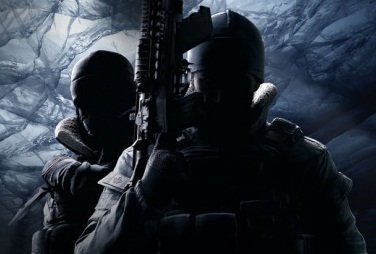

 Google Maps Will Fail You; Here Are 5 Skills That Can Save You
Google Maps Will Fail You; Here Are 5 Skills That Can Save You Lets Plays, Nintendo and the Audacity of Monetization
Lets Plays, Nintendo and the Audacity of Monetization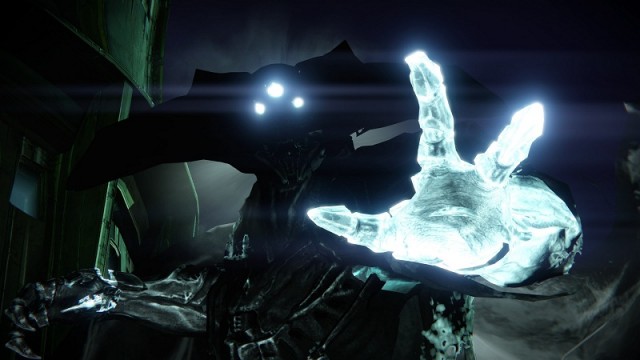 Destiny: The Taken King - How to use the Dreadnaught Map Glitch
Destiny: The Taken King - How to use the Dreadnaught Map Glitch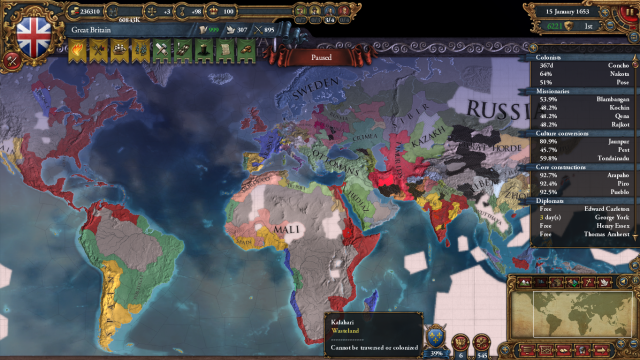 You Should Play Europa Universalis IV
You Should Play Europa Universalis IV Top 5 Best Gaming Phones of 2015
Top 5 Best Gaming Phones of 2015